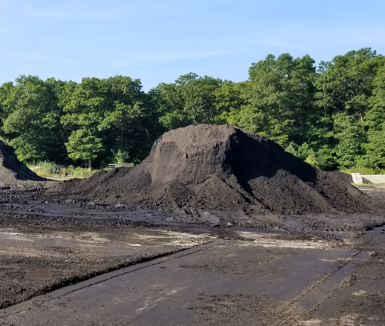
High quality topsoil can mean the difference between a successful growing season or a disappointing harvest. In order to support the sufficient growth of plants, topsoil should be rich in nutrients and minerals. Thankfully, compost material can be incorporated into the upper layers of soil in gardens or lawns to make a low-quality topsoil better.
According to the New York State Department of Conservation (NYSDEC), compost is produced through the “aerobic, thermophilic decomposition of organic waste to produce a stable, humus-like material.” It can be created using a variety of organic materials such as yard trimmings, animal manure, bedding or crop residues, food processing wastes, fats, oil, grease, etc.

The quality of the compost material used to amend soil for plant growth depends on several factors, which can be measured through laboratory analysis, including the following:
- Compost Moisture
The laboratory value of compost moisture is a measure of the water content (wet weight) of the compost as a percentage. The presence of water in compost is important because microorganisms require certain amounts of water in order to breakdown the organic material. However, too much water can also present anaerobic conditions.
- Bulk Density
Bulk density is the amount of topsoil in a given volume and is typically reported in pounds per cubic yard. High values of bulk density can indicate that your compost is too compacted which reduces the required aeration for proper microbial activity.
- Organic Matter
The amount of organic matter in the topsoil is dependent on the amount of carbon, hydrogen, oxygen, and nitrogen. Topsoil with low organic matter may lack the nutrients necessary for maximized plant growth. In order to increase the organic matter of topsoil, high-quality compost can be added.
- pH and Electrical Conductivity (soluble salts)
The ideal pH and electrical conductivity depend on the nature of the plants that the topsoil is being used for. Some plants may require a slightly acidic pH; however, a neutral pH is sufficient for most applications. Similarly, certain levels of salinity are required for crop productivity.
- Nutrients
Nutrients of interest that can be tested for include the following:
- Total Nitrogen
- Carbon to Nitrogen C:N ratio
- Ammonium and Nitrate
- Macro and micronutrients including Phosphorus, Potassium, Calcium, Magnesium, Sulfur, Zinc, Manganese, Copper, Iron, and Boron.
As mentioned prior, sufficient levels of these nutrients can determine plant growth productivity. It is important to make sure to add compost to any topsoil you believe is lacking nutrients so that you won’t be left disappointed at the end of the growing season.
If you’re unsure whether your topsoil is high-quality or not, Walden can help take samples and interpret the results to ensure you’re on the right track, whether its gardening or landscaping. Call Walden Environmental Engineering at 516-624-7200 to speak to one of our solid waste engineers who have vast experience in composting operations to help you.
